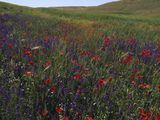What Is the Definition of Composer in Biology
Think of the power plant in your town. It turns energy from fuel, such as coal or natural gas, into another form of energy, electricity, that powers your lights and appliances. Now think of the trees on your street. Green plants are the original "power plants." They capture energy from the sun and combine it with inorganic, or nonliving, materials to make organic molecules. These molecules are the fuel that powers all other living things. This special ability to take power from the sun earns plants (along with certain other organisms, including algae and some bacteria) the title of "producers. How do producers work this magic of storing the energy from sunlight in molecules that other organisms can use? They accomplish this feat with a biochemical reaction called photosynthesis. This process uses the energy of sunlight to split water molecules into hydrogen and oxygen. It then combines the hydrogen with carbon dioxide from the air and minerals from the soil to make glucose (a sugar) and other more complex organic molecules. Plants release oxygen as a by-product of these reactions. Producers are the foundation of every food web in every ecosystem—they occupy what is called the first tropic level of the food web. The second trophic level consists of primary consumers—the herbivores, or animals that eat plants. At the top level are secondary consumers—the carnivores and omnivores who eat the primary consumers. Ultimately, decomposers break down dead organisms, returning vital nutrients to the soil, and restarting the cycle. Another name for producers is autotrophs, which means "self-nourishers." There are two kinds of autotrophs. The most common are photoautotrophs—producers that carry out photosynthesis. Trees, grasses, and shrubs are the most important terrestrial photoautotrophs. In most aquatic ecosystems, including lakes and oceans, algae are the most important photoautotrophs. Ecosystems where there is not enough sunlight for photosynthesis to occur are powered by chemoautotrophs—primary producers that do not use energy from the sun. Instead, they break apart inorganic chemical compounds, such as hydrogen sulfide, and use the energy released to make organic molecules. Only bacteria and certain other microorganisms are chemoautotrophs. They are much less abundant than photoautotrophs. Some live in soil, while others live deep in the ocean, around volcanic features called hydrothermal vents. Earth's climate affects producers; the abundance of photoautotrophs increases as you move from the poles toward the equator due to the warmer weather and more intense sunlight. Scientists are working to understand how global climate change may be affecting plant growth. They are also studying how primary producers might be able to moderate climate change through their ability to absorb carbon dioxide, an important greenhouse gas.

Producers, like these wildflowers at the Ziz River Valley in Morocco, form the basis of any food web. They take in energy needed to grow and reproduce from the sun. Producers, in turn, are used as energy for consumers at the next level of the trophic hierarchy.
Photograph by James L. Stanfield
algae
Plural Noun
(singular: alga) diverse group of aquatic organisms, the largest of which are seaweeds.
Noun
organism that can produce its own food and nutrients from chemicals in the atmosphere, usually through photosynthesis or chemosynthesis.
Plural Noun
(singular: bacterium) single-celled organisms found in every ecosystem on Earth.
carbon dioxide
Noun
greenhouse gas produced by animals during respiration and used by plants during photosynthesis. Carbon dioxide is also the byproduct of burning fossil fuels.
climate
Noun
all weather conditions for a given location over a period of time.
Noun
gradual changes in all the interconnected weather elements on our planet.
hydrogen sulfide
Noun
chemical compound gas responsible for the foul odor of rotten eggs.
microscopic
Adjective
very small.
mineral
Noun
nutrient needed to help cells, organs, and tissues to function.
Noun
substance an organism needs for energy, growth, and life.
organism
Noun
living or once-living thing.
oxygen
Noun
chemical element with the symbol O, whose gas form is 21% of the Earth's atmosphere.
Noun
process by which plants turn water, sunlight, and carbon dioxide into water, oxygen, and simple sugars.
primary consumer
Noun
organism that eats producers; herbivores.
primary producer
Noun
organisms, such as plants and phytoplankton, that can produce their own food through photosynthesis or chemosynthesis; also called autotrophs.
secondary consumer
Noun
organism that eats meat.
trophic level
Noun
one of three positions on the food chain: autotrophs (first), herbivores (second), and carnivores and omnivores (third).
What Is the Definition of Composer in Biology
Source: https://www.nationalgeographic.org/encyclopedia/producers/